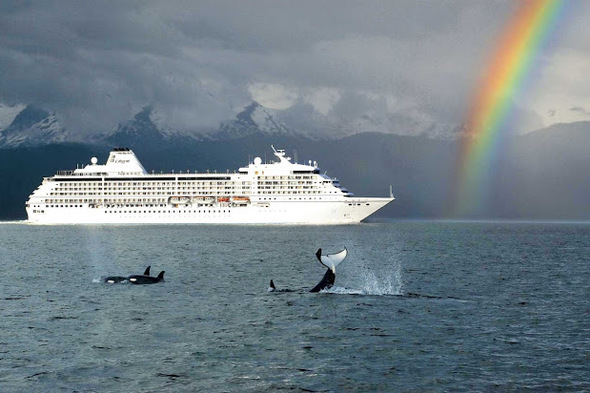Ultimately, though, surely everything should be about keeping people safe, and reducing the spread of the coronavirus into communities where it is currently not prevalent?
It is refreshing to see the cruise industry lead on customer safety rather than 'how do we get round the rules'… Whatever you might feel about the draconian Centers for Disease Control (CDC) in the United States, and their apparent hostility to the cruise industry, the fact is they are focused on public health. Scott Gottlieb, formerly of the US Food and Drug Administration and co-chair of the Healthy Sail Panel created by Royal Caribbean and NCLH, speaking recently at the CLIA (Cruise Lines International Association) Cruise Forward conference, acknowledged there are other equivalently risky environments which are completely unregulated.
"It depends whose regulatory purview your industry is in," he says. "The fact that there is asymmetric regulation does not mean the CDC regulation is wrong. But this uneven regulation from a public health point of view is very inefficient."

A whole number of detailed documents have been produced, including the EU Healthy Gateways document in mainland Europe, the Healthy Sail Panel recommendations, the Chamber of Shipping framework produced in collaboration with CLIA in the UK, and finally the CDC framework (conditional sail order). All agree on a multi-layered approach, with no single action being the silver bullet to prevent infection on board ships. As Richard Fain of Royal Caribbean has said, "think of it as slices of a holey cheese - no single slice is hole-free, but put them all together and you have an impenetrable barrier." Or nearly impenetrable - no document claims that 100% safety against the virus can be achieved - it is a question of mitigation of risk, rather than total risk prevention.
As we know, a tentative nod of approval to the resumption of cruise operations does not mean that cruises will immediately restart. Reactivating a ship is a massive job, even before the implementation of additional safety measures. At least that is now under way as cruise lines begin to see a way to resume operations from Q2 in 2021.
So much for the regulations. But what our clients want to know is, what will it actually be like when they come back?

A recent YouTube video relating to the boarding process for the newly resumed Dream Cruises programme out of Singapore gives you a remarkable amount of information about a very detailed embarkation process, which includes mandatory online check-in well before your cruise, the requirement to download a relevant app, pre-assigned arrival times at the port, pre-cruise antigen rapid tests at the port (with a one hour wait for negative results), SafeEntry check-in to include temperature screening and submission of a health declaration form, the supply of a MICE Pod to carry with you at all times (used for Safe Management Measures adherence and contact tracing), and finally timed boarding onto the ship with electronic documents and a final temperature test, with plenty of hand sanitising along the way. And that's before your cruise has even started.
During the cruise, measures introduced include the requirement to wear a mask in public areas, except for dining and engaging in sports activities, social distancing rules for onboard activities, timed check-in to food outlets, table service or served buffets, timed entry to the gym, deck area, pool and Jacuzzi, and sanitisers and washing facilities at all venues. With 100% fresh air ventilation around the ship, and enhanced cleaning and foggers throughout, your safety is well taken care of. As for disembarkation, once more it will be timed, with temperature screening and a final ART test.

Likewise there will be detailed protocols from the cruise terminals and port authorities around the world. One outcome we might all welcome is a reduction of the number of ships allowed to dock in a port at any one time. During the European resumption this past summer, guests were only allowed to leave the ship on organised shore excursions, enabling the cruise lines, in conjunction with their land-based tour partners, to control the bubble and ensure measures were in place to keep the tours safe and infection-free.
In the early stages, passenger numbers will be reduced, creating a better crew-to-passenger ratio, and also enabling accommodation to be held off for quarantine or isolation where necessary.
Is all of this putting you off? It seems to us that whilst all these measures represent a highly labour intensive challenge to the cruise lines, ports, local operators and so forth, their task is to ensure, through the use of efficient procedures and excellent technology, that you as a passenger barely notice they are happening. And by 2022, there will probably be minimal testing as the vaccine is administered globally, protecting guests and crew as well as reducing not only the spread, but also the virulence of the disease.
Finally, the new vaccines… I think we can all agree that these are indeed the 'silver bullets' needed to enable global travel to resume. The next question is, will proof of vaccination be required to enable people to travel again, or will an assumption be made that once the uptake is sufficiently widespread, herd immunity will kick in and the epidemic will slow to almost nothing, so regular testing will be all that is needed? Time will tell…
As for evidence that you have indeed been vaccinated, the World Economic Forum and The Commons Project Foundation already have plans and will begin rolling out CommonPass shortly on five airlines. A strength of CommonPass is that it lets people demonstrate their Covid status while protecting their data privacy.

In this fast-moving post-Covid world I know that every article I write on the 'future of cruise' is likely to be out of date in just a few weeks. The above comments are simply my opinion at the beginning of December 2020.






